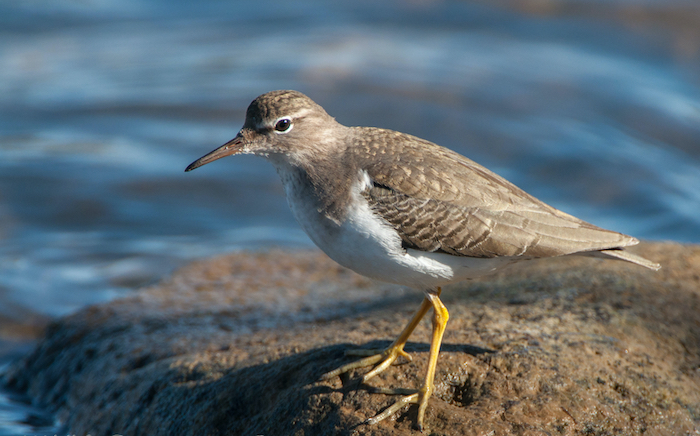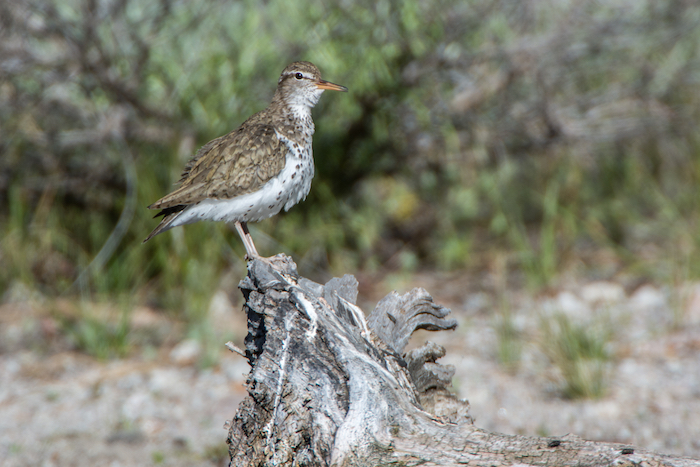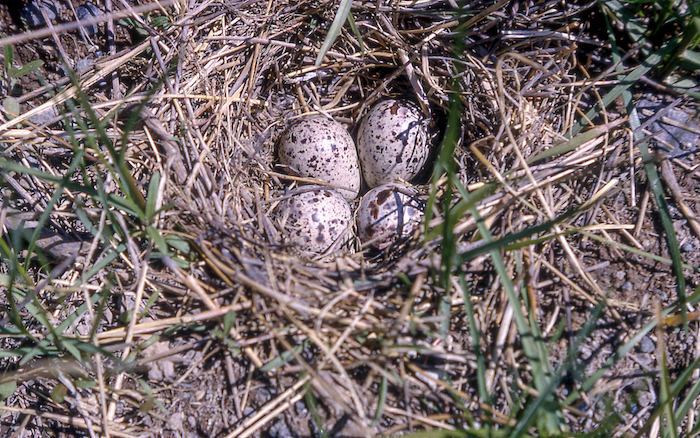
Spotted Sandpiper
If you stroll along the river much this winter you’ll likely see a brown bird the size of a handspan doing the same thing. But you might notice that, unlike you, it is busy poking about the shoreline for insects and crustaceans, and its hind end bobs up and down almost incessantly. The bird may stop bobbing to fly skittering away from you, low over the water’s surface, showing white wing-stripes through its gray-brown topside. This bouncing bird is the spotted sandpiper.
Now don’t expect the spotted sandpiper to have spots this time of year. Spots are a dress-up item for the breeding season, dark dots boldly decking the bird’s white breast and belly, and their brown backsides, too. For now, though, they live their lives plainly–unadorned brown and white, always over or along water, and with just their tail-bobbing to provide some flair.
Spring, however, brings more than spots to these little shorebirds. They are one of the handful of species who break the breeding pattern common to birds and large fauna in general.

Most sandpipers breed in the Far North, where the twenty-four hour sun spurs explosive growth of plants and lichens, and the hordes of insects that feed on them. Those insects are food for millions of birds, and crucial to their efforts to feed their young. That environment is rich, but only briefly so. Winter encroaches at it from both ends. To nest there, sandpipers have evolved young who develop fast. They lay large eggs; the chicks emerge precocial, ready to run and feed themselves. To guide and protect their chicks through their brief, busy childhood, parents bond for at least a season, and sometimes for multiple seasons.
But spotted sandpipers, those bobbing birds along our riverbank, have spread their nesting grounds to include not just the Far North but rivers, mountain lakes and meadows, flats and shorelines throughout Canada and most of the US. They are the most widespread sandpiper on the continent. This gives them a longer nesting season than their Arctic cousins. But the females still lay those large precocial eggs, each egg 20% of its mother’s weight. They don’t produce more than four for a single nest; the physical toll seems to be too high.

Spotted Sandpiper Nest with Eggs
To take advantage of the longer warm season, perhaps the birds could raise two broods, as many songbirds do. But nature finds many ways to solve life’s puzzles. Spotted sandpipers maximize their reproduction by having the females focus on egg-laying and the males focus on child-rearing.
At breeding season, female spotted sandpipers establish breeding territories which they vigorously defend from other females and where they court up to four males with elaborate swooping displays and strutting. Over a 6-7 week breeding season, they lay an average of eight eggs but as many as twenty, with never more than four in a nest. The total number of eggs seems to be determined by the availability of food and males. For their part, the males separately tend and protect, even from one another, their individual nests and hatchlings.
Biological changes have evolved to support this reproductive process. At breeding season, females undergo a sevenfold increase in their testosterone, promoting their active courting and territory defense. Males produce high levels of prolactin, a hormone that promotes parental care-giving.
While nature has pioneered this reproductive technique, nature does not guarantee the success of any particular strategy. Like many species, spotted sandpipers, despite being widespread, have declined over 50% in the last fifty years. What comes next for them remains unknown.
Another unknown is the function of sandpiper tail-bobbing. Guesses range from the mildly plausible – say, aiding in balancing on rough terrain – to the absurd – say, pumping body oils over their feathers to improve waterproofing. That latter reckoning is imaginative, but completely lacks physiological evidence. Since convincing explanations still elude us, the hypothesizing is wide open. Have at it!

No comments yet.